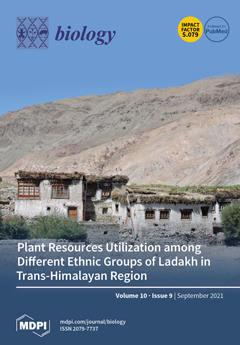Helicobacter pylori is capable of entering into yeast, but the factors driving this endosymbiosis remain unknown. This work aimed to determine if temperatures outside the optimal range for
H. pylori increase its harboring within
Candida.
H. pylori strains were co-cultured with
Candida
[...] Read more.
Helicobacter pylori is capable of entering into yeast, but the factors driving this endosymbiosis remain unknown. This work aimed to determine if temperatures outside the optimal range for
H. pylori increase its harboring within
Candida.
H. pylori strains were co-cultured with
Candida strains in Brucella broth supplemented with 5% fetal bovine serum and incubated at 4, 25, 37 or 40 °C. After co-culturing, yeasts containing bacteria-like bodies (Y-BLBs) were observed by optical microscopy, and the bacterium were identified as
H. pylori by FISH. The
H. pylori 16S rRNA gene was amplified from the total DNA of Y-BLBs. The viability of intra-yeast
H. pylori cells was confirmed using a viability assay. All
H. pylori strains were capable of entering into all
Candida strains assayed. The higher percentages of Y-BLBs are obtained at 40 °C with any of the
Candida strains.
H pylori also increased its harboring within yeast in co-cultures incubated at 25 °C when compared to those incubated at 37 °C. In conclusion, although
H. pylori grew significantly at 40 °C, this temperature increased its harboring within
Candida. The endosymbiosis between both microorganisms is strain-dependent and permits bacterial cells to remain viable under the stressing environmental conditions assayed.
Full article






